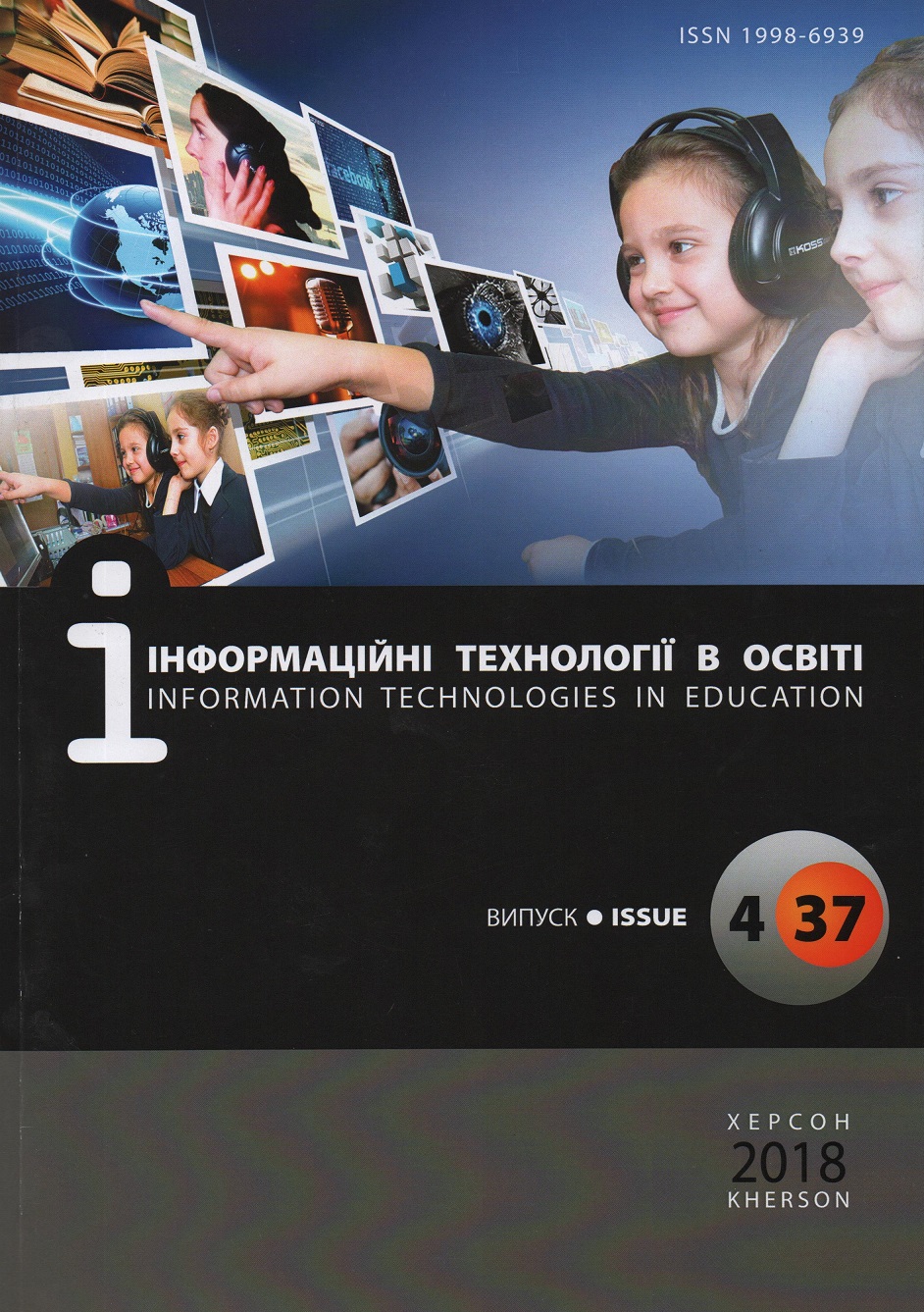MODEL OF ORGANIZATION OF THE UNIVERSITY ECOSYSTEM FOR THE DEVELOPMENT OF STEM-EDUCATION
DOI:
https://doi.org/10.14308/ite000682Keywords:
robotics, educational robotics, STEM, ICT, LLL, robotics after school programs, pre- and in-service teachers, certification, standards, post-secondary educationAbstract
The development of artificial intelligence systems in the near future will lead to a reduction in routine, template work. The toolkit changes in most professions. There is a need for a quick retraining of a specialist and the use of computer systems. Nowadays, separate devices and systems have been created that can solve some of the problems that appear in everyday life. Therefore, STEM education is one of the directions that is in demand in society.
During last few years in Ukraine there has been a rapid increase in the number of technical groups – robotics and programming. All of them are different of organization, types of classes, target audience. We made an effort to summarize the information received on this issue. In this article we analyze the situation on the market of educational services of the STEM-direction in Ukraine and in other countries, consider the existing technical and methodological support of STEM-education, as well as the experience of creating a STEM-school based on the post-graduate education center of Kherson State University. We describe the steps needed to create such a structure, its place in the educational system. Also we describe the experience of developing the material for the development of curricula, a series of events that promote the attraction of researches, and the introduction of digital technologies in the educational process.
The pace and breadth of the STEM movement, as well as the support and interest of the state in Ukraine, show that, within three to five years, STEM-based methods and tools will be almost fully integrated into school curricula. At the same time, the material and technical support, as well as the professional development of teachers, are crucial for the pace of integration.
The creation of a STEM center at the university, in which both future engineers and future teachers are trained, makes it possible to create a harmonious ecosystem in the region for the development of new technologies in the region.
Downloads
Metrics
References
1. Noonan, R. (2017). Office of the Chief Economist, Economics and Statistics Administration, U.S. Department of Commerce. STEM Jobs: 2017 Update (ESA Issue Brief #02-17). Retrieved from http://www.esa.doc.gov/sites/default/files/stem-jobs-2017-update.pdf.
2. Executive Summary (2016). The Future of Jobs and Skills. Retrieved from https://www.weforum.org/agenda/2016/03/21st-century-skills-future-jobs-students/.
3. Prinsley, R., Beavis, A.S. & Clifford-Hordacre, N. (2016). Busting myths about women in STEM. Retrieved from http://www.chiefscientist.gov.au/wp-content/uploads/OCS-paper-13.pdf.
4. LinkedIn (2017). Women in Tech: 40% of LinkedIn Top Voices 2017 in Technology are women: What an achievement. Retrieved from https://www.linkedin.com/pulse/40-linkedin-top-voices-2017-technology-women-what-muqbil-ahmar/.
5. UNESCO International Symposium and Policy Forum. (2017). Cracking the code : girls' education in STEM. Retrieved from http://unesdoc.unesco.org/images/0025/002534/253479E.pdf.
6. The Forbes (2017). These 5 High-Paying, Fast-Growing STEM Professions Need More Men. Retrieved from https://www.forbes.com/sites/metabrown/2017/10/29/these-5-high-paying-fast-growing-stem-professions-need-more-men/7/#930f06630c46.
7. Trotman, A. (2017). Why don’t European girls like science or technology? Retrieved from https://news.microsoft.com/europe/features/dont-european-girls-like-science-technology/#W3R2xCW Jmc HeAkSH.99
8. Kushnir, N., Valko, N. & Osipova, N. (2017). Review Of Trends, Approaches And Perspective Practices Of Stem-Education For Training Center Opening. Informational Technologies in Education, 31, 69-80.
9. Tomatosphere (2017). Planting The Seed For Space Exploration. Retrieved from http://amz.xcdsystem.com/4F14E44B-BC41-E69B-DFAF5A1B1627A0EA_abstract_File8313/ Upload PDF_65_0710041118.pdf
10. NASA Education. (2018). For Students. Retrieved from https://www.nasa.gov/audience/forstudents/9-12/features/first-robotics-index.html#.UjdnIXfleSo.
11. NASA Education. (2018). About NASA STEM Engagement. Retrieved from https://www.nasa.gov/offices/education/about/index.html.
12. Google (2016). Diversity Gaps in Computer Science: Exploring the Underrepresentation of Girls, Blacks and Hispanics. Retrieved from http://services.google.com/fh/files/misc/diversity-gaps-in-computer-science-report.pdf.
13. United States Department of Labour (2015). Occupational Employment Statistics. Retrieved from https://www.bls.gov/oes/2015/may/stem.htm.
</uk>
<en>
1. Noonan, R. (2017). Office of the Chief Economist, Economics and Statistics Administration, U.S. Department of Commerce. STEM Jobs: 2017 Update (ESA Issue Brief #02-17). Retrieved from http://www.esa.doc.gov/sites/default/files/stem-jobs-2017-update.pdf.
2. Executive Summary (2016). The Future of Jobs and Skills. Retrieved from https://www.weforum.org/agenda/2016/03/21st-century-skills-future-jobs-students/.
3. Prinsley, R., Beavis, A.S. & Clifford-Hordacre, N. (2016). Busting myths about women in STEM. Retrieved from http://www.chiefscientist.gov.au/wp-content/uploads/OCS-paper-13.pdf.
4. LinkedIn (2017). Women in Tech: 40% of LinkedIn Top Voices 2017 in Technology are women: What an achievement. Retrieved from https://www.linkedin.com/pulse/40-linkedin-top-voices-2017-technology-women-what-muqbil-ahmar/.
5. UNESCO International Symposium and Policy Forum. (2017). Cracking the code : girls' education in STEM. Retrieved from http://unesdoc.unesco.org/images/0025/002534/253479E.pdf.
6. The Forbes (2017). These 5 High-Paying, Fast-Growing STEM Professions Need More Men. Retrieved from https://www.forbes.com/sites/metabrown/2017/10/29/these-5-high-paying-fast-growing-stem-professions-need-more-men/7/#930f06630c46.
7. Trotman, A. (2017). Why don’t European girls like science or technology? Retrieved from https://news.microsoft.com/europe/features/dont-european-girls-like-science-technology/#W3R2xCW Jmc HeAkSH.99
8. Kushnir, N., Valko, N. & Osipova, N. (2017). Review Of Trends, Approaches And Perspective Practices Of Stem-Education For Training Center Opening. Informational Technologies in Education, 31, 69-80.
9. Tomatosphere (2017). Planting The Seed For Space Exploration. Retrieved from http://amz.xcdsystem.com/4F14E44B-BC41-E69B-DFAF5A1B1627A0EA_abstract_File8313/ Upload PDF_65_0710041118.pdf
10. NASA Education. (2018). For Students. Retrieved from https://www.nasa.gov/audience/forstudents/9-12/features/first-robotics-index.html#.UjdnIXfleSo.
11. NASA Education. (2018). About NASA STEM Engagement. Retrieved from https://www.nasa.gov/offices/education/about/index.html.
12. Google (2016). Diversity Gaps in Computer Science: Exploring the Underrepresentation of Girls, Blacks and Hispanics. Retrieved from http://services.google.com/fh/files/misc/diversity-gaps-in-computer-science-report.pdf.
13. United States Department of Labour (2015). Occupational Employment Statistics. Retrieved from https://www.bls.gov/oes/2015/may/stem.htm.
</en>
Downloads
Published
How to Cite
Issue
Section
License
This work is licensed under a Creative Commons Attribution-NonCommercial-ShareAlike 4.0 International License.






























